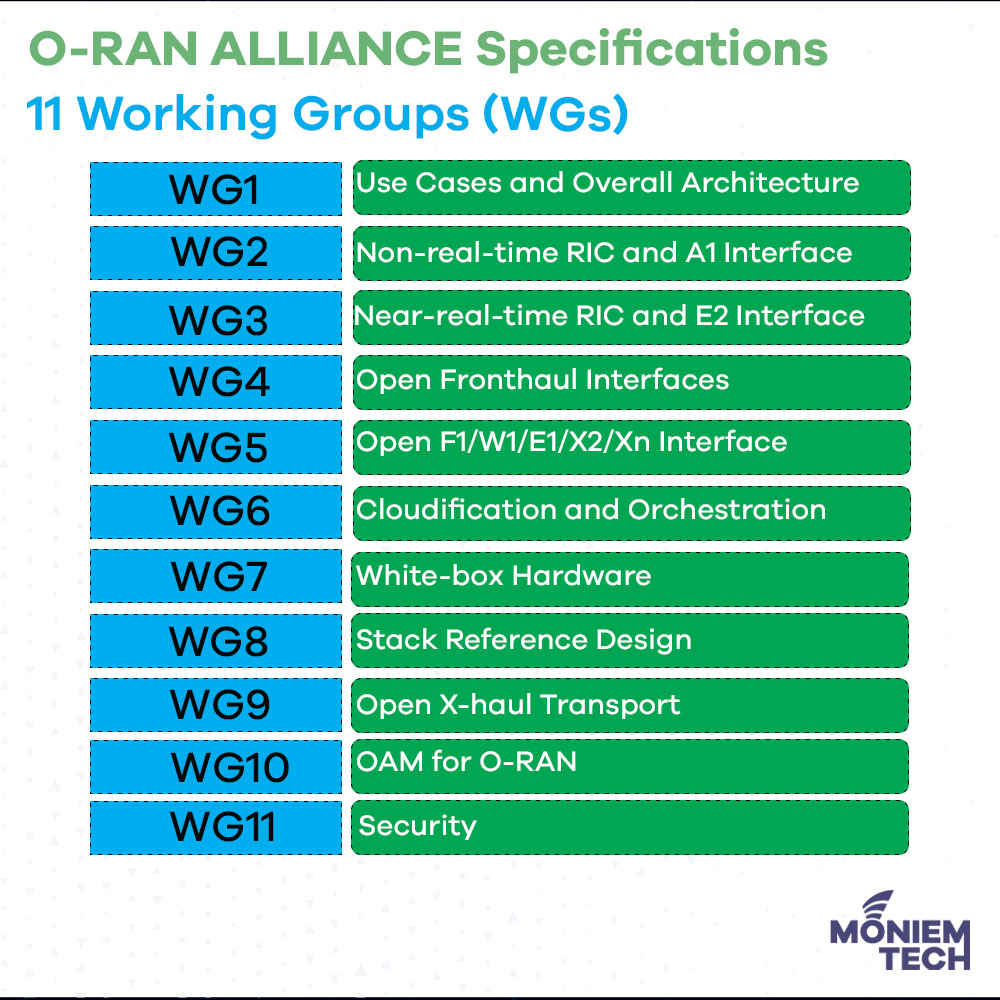The O-RAN Alliance (O-RAN) is a group that is defining specifications for radio access networks. It is a global alliance founded in 2018 and it is now comprised of close to 30 operators and more than 200 vendor companies. The O-RAN Alliance is a relatively new organization that took the 3GPP standards work as its baseline and set out to create extensions specifically for the RAN. The goals are to provide detailed blueprints for how to build the RAN solution enabling parts from different vendors, including mechanisms for enabling artificial intelligence and machine learning for more efficient network management and orchestration.
The O-RAN specification work has been divided into technical Work Groups (WG), all of them under the supervision of the Technical Steering Committee. Each of the WGs covers a part of the O-RAN Architecture. All WGs are open to all Members and Contributors.

-
WG1: Use Cases and Overall Architecture Work Group
It has overall responsibility for the O-RAN Architecture and Use Cases. WG 1 identifies tasks to be completed within the scope of the Architecture and Use Cases and assigns Task Group leads to drive these tasks to completion while working across other O-RAN Work Groups. -
WG2: The Non-Real-Time RAN Intelligent Controller and A1 Interface Work Group
The primary goal of Non-RT RIC is to support Non-Real-Time intelligent radio resource management, higher-layer procedure optimization, policy optimization in RAN, and providing AI/ML models to Near-RT RIC. -
WG3: The Near-Real-Time RIC and E2 Interface Work Group
The focus of this WG is to define an architecture based on a Near-Real-Time Radio Intelligent Controller (Near-RT RIC), which enables near-real-time control and optimization of RAN elements and resources via fine-grained data collection and actions over E2 interface. -
WG4: The Open Fronthaul Interfaces Work Group
The objective of this WG is to deliver truly open fronthaul interfaces, in which multi-vendor DU-RRU interoperability can be realized. -
WG5: The Open F1/W1/E1/X2/Xn Interface Work Group
The objective of this WG is to provide fully operable multi-vendor profile specifications (which shall be compliant with 3GPP specification) for F1/W1/E1/X2/Xn interfaces and in some cases will propose 3GPP specification enhancements. -
WG6: The Cloudification and Orchestration Work Group
The cloudification and orchestration WG seeks to drive the decoupling of RAN software from the underlying hardware platforms and to produce technology and reference designs that would allow commodity hardware platforms to be leveraged for all parts of a RAN deployment including the CU and the DU. -
WG7: The White-box Hardware Work Group
The promotion of open reference design hardware is a potential way to reduce the cost of 5G deployment that will benefit both the operators and vendors. The objective of this Work Group is to specify and release a complete reference design to foster a decoupled software and hardware platform. -
WG8: Stack Reference Design Work Group
The aim of this WG is to develop the software architecture, design, and release plan for the O-RAN Central Unit (O-CU) and O-RAN Distributed Unit (O-DU) based on O-RAN and 3GPP specifications for the NR protocol stack. -
WG9: Open X-haul Transport Work Group
This WG focuses on the transport domain, consisting of transport equipment, physical media, and control/management protocols associated with the transport network. -
WG10: OAM Work Group
This WG is responsible for the OAM requirements, OAM architecture, and the O1 interface. -
WG11: Security Work Group
This WG focuses on the security aspects of the open RAN ecosystem.
